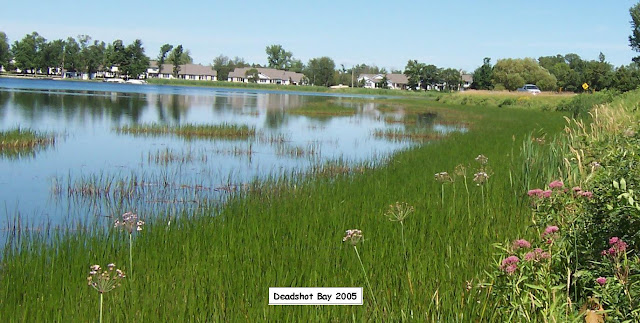On June 21,
2013 approximately 183 acres along the shores of Big, Little Detroit and Deadshot Bay (Curfman) were treated in a attempt to
control Flowering Rush (FR). Fourteen more
acres were treated in the City’s beach area in the Park and along West Lake Drive. Additional treatments took place in Lakes Melissa
and Sallie.
The treatments were
paid for by taxpayers under the auspices of the Pelican River Watershed District
(PRWD) and the City of Detroit Lakes.
The actual treatments were carried out by Professional Lakes Management (PLM),
authorized and supervised by the Minnesota Department of Natural
Resources.
Flowering
Rush was first observed in these waters in 1976. Some
insist that the plant was set along
the shore of Deadshot Bay (Curfman Lake) as part of a residential landscaping
effort. No one has provided any direct
knowledge of that act, but genetic
research indicates that our FR is derived from nursery stock.
Even in the
late 1970’s Deadshot
Bay residents realized
that Flowering Rush was a problem and began hand-pulling. It did not take long to learn those efforts
were not solving the problem, so residents turned to the PRWD for help. In the late 1980’s for at least two years
District staff used both granular and spray
forms of an aquatic version of Roundup (glysophate) to treat FR in Detroit and Sallie,
especially in Deadshot Bay, and
near Long Bridge and other beaches where there were heavy infestations. Though permitted by DNR, the approach was
considered unsuccessful.
Hand-pulling
continued into the early nineties,
sometimes by teams recruited by Lake Detroiters and other
groups. Also, because of the plant’s
flowering habit and the expectation that the plant was spreading via seeds from
the flowers, some efforts were made to remove the plant’s flowers during their
July blooming period. (Later it was
discovered that our FR seeds were sterile, and the plants spread entirely by root
fragment growth or dispersal.)
In the
meantime Detroit
residents petitioned the District
for a project to buy a machine to harvest FR. Some mechanical harvesting had
occurred using borrowed equipment in before, but new harvesting equipment was
deployed in 1991, and it was used largely for FR management until 2005. At its peak in 2002, just over 1600 tons of
plant debris, mostly FR, was removed
from the lake.
The
harvesting strategy was adopted because of the view, reinforced by some
experts, that multiple harvest of FR stems would deprive the root mass of
energy. This was an approved strategy
by the DNR, and even as recently as 2010, was their recommended method of FR control.
Except that
by 2002 District staff had come to the conclusion that though the harvesting
equipment provided some aesthetic
relief from the scourge of FR, it did not offer a significant amount of control
of the plant, nor did it prevent the spread of the nuisance.
In 2003 the
District began testing several herbicides with six test sites on Big Detroit and Dead Shot Bay. Nearby control sites were employed to
evaluate the testing. During the
following year, some additional sites were used for other herbicides. Different chemical formulations and
different application methods were
used. Though results were inconclusive
the District was allowed for several more years to do some more extensive
treatment with Imazypyr on emergent stands of FR. Some control was obtained, but emergent
plants in deeper water, and submerged plants were unaffected and continued to
spread.
In 2009 PRWD
held a public meeting to obtain
input from almost 100 citizens and local officials. As one outgrowth from that effort the
District called together experts
from across the nation for a meeting
in St. Paul to
consider further treatment strategies.
That meeting led to
District-initiated multi-pronged research on the nature of FR and some
alternative treatment efficacies. A collaborative effort involving Mississippi
State University Institute of Geosciences, the Army Corps of Engineers, and
Concordia College (Moorhead), supported by the taxpayers of the District, the
City of Detroit Lakes, and the
Minnesota DNR, was carried on in 2010, 2011 and 2012, and led directly to last
week’s expanded treatment program utilizing the herbicide Diquat. On-going research on treatment impacts on
Flowering rush and native aquatic plants directed by Dr. John Madsen of
Mississippi State Geosciences Institute will continue with funds provided by PRWD.
RDH
06/28/13




No comments:
Post a Comment